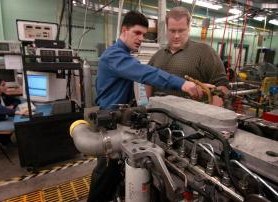 Even with the inexorable move toward electrically driven cars in the next couple of decades, the internal combustion engine will remain with us for some time to come either as the primary powertrain on many vehicles or at least as an auxiliary power unit for series hybrid vehicles. Given that reality, researchers are working feverishly on ways to improve the efficiency of ICEs as much as possible. During the recent SAE World Congress speakers from almost every carmaker and research facility talked about a new combustion process called homogeneous charge compression ignition or HCCI.
Even with the inexorable move toward electrically driven cars in the next couple of decades, the internal combustion engine will remain with us for some time to come either as the primary powertrain on many vehicles or at least as an auxiliary power unit for series hybrid vehicles. Given that reality, researchers are working feverishly on ways to improve the efficiency of ICEs as much as possible. During the recent SAE World Congress speakers from almost every carmaker and research facility talked about a new combustion process called homogeneous charge compression ignition or HCCI.
In the world of internal combustion engines there are two basic ways of igniting the air/fuel mixture to make power, using an electrical spark or compressing the mixture until the temperature reaches a point where the mixture self ignites. The first is used in typical gasoline engines and the second in diesel engines. The HCCI combustion process takes some of both processes and has only recently started to look like a viable alternative as electronic control systems and sensors have gotten more powerful and precise.
Continue reading after the jump.
[Source: ScienceDaily.com]
HCCI engines have the potential to reduce fuel consumption by fifteen to twenty percent or more which also means a reduction in CO2 emissions by a similar amount. This would bring them close to parity with diesel engines. HCCI engines run at extremely lean air fuel ratios as do modern diesel engines. Newer diesels use the lean air fuel mixtures in part to reduce particulate emissions. The problem in lean running diesels is that the temperature of the burning air/fuel mixture is very high which causes nitrogen oxides to be produced in addition to the CO2. That's where HCCI differs because the combustion temperature is much lower resulting in very little NOx production.
HCCI engines can run on gasoline but use compression ignition like a diesel. They run on an extremely lean mixture, as much 34:1 compared to a regular gas engine that typically runs somewhere around 14.7:1. Exhaust gases are blended into the mixture which raises the temperature and helps the ignition. However unlike a diesel the compression ratio is much lower which results in much lower combustion temperatures. The blending of the exhaust gases with the lean air-fuel mixture also results in much more even mixtures which tend to ignite more uniformly across the entire combustion chamber.
While all of this is great in theory making it all work is extremely difficult. Controlling the air-fuel mixture precisely is paramount and that's where Prof. Gregory M Shaver and his team at Purdue University come in. They have been working on modeling the behavior of HCCI engines and developing control algorithms to manage the valve timing and fuel flow in order to optimize the efficiency and performance of this new combustion process. They have come up with a way to monitor performance in each cylinder during each revolution of the engine and then adjust the parameters of the valve opening and closing to get the right compression ratio and exhaust gas amounts into the cylinder. HCCI is a very promising combustion process and you'll be hearing more about hear in the near future.


Sign in to post
Please sign in to leave a comment.
Continue